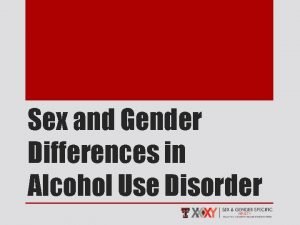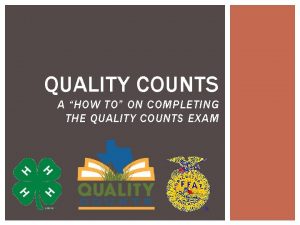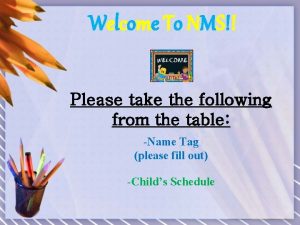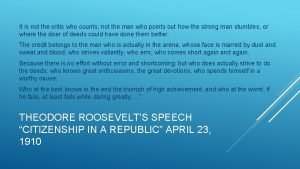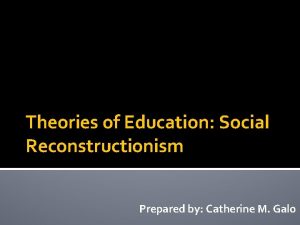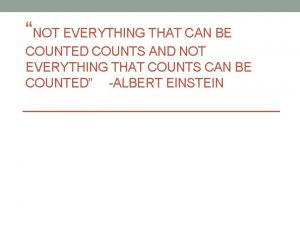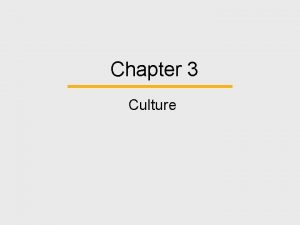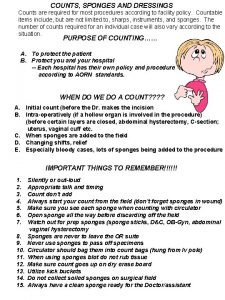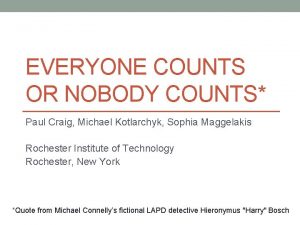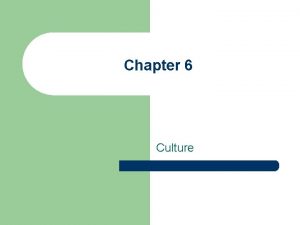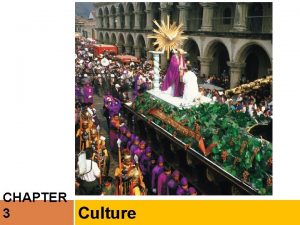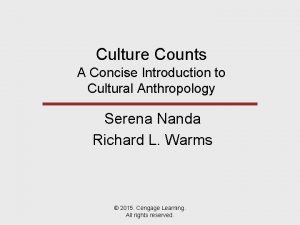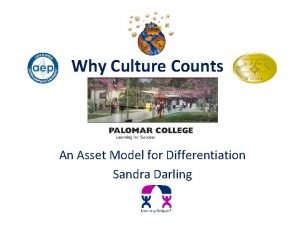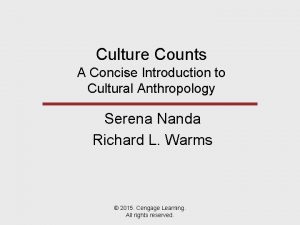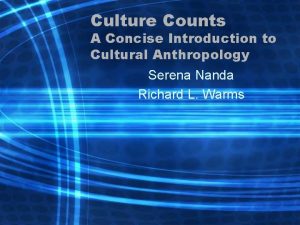Chapter 2 Culture Counts Chapter Outline Culture and





































- Slides: 37

Chapter 2 Culture Counts

Chapter Outline • • Culture and Autism Culture Is Made Up Of Learned Behaviors Culture Is The Way Humans Use Symbols To Organize And Give Meaning To The World Culture Is An Integrated System—Or Is It?

Chapter Outline • • • Culture Is A Shared System Of Norms And Values—Or Is It? Culture Is The Way Human Beings Adapt To The World Culture Is Constantly Changing Culture Counts Bringing It Back Home: Yes, But Is It Science?

Autism and Culture • • Autism is a developmental disorder characterized by difficulties in verbal and nonverbal communication, impairment of social interaction, and other symptoms. Some with autism have exceptional intellectual skills, such as Dr. Temple Grandin, an associate professor of animal science at Colorado State University.

Autism and Culture • • • Dr. Grandin is known for her work in the humane slaughter of cattle and has written extensively on her experience with autism. According to Grandin, autistics think in concrete terms and have profound difficulty understanding social conventions. Through observation and analysis she has learned many of the rules of cultural behavior.

Characteristics of Culture 1. 2. 3. Cultures are made up of learned behaviors. All cultures involve the use of language and symbols. Cultures are patterned and integrated.

Characteristics of Culture 4. 5. 6. Cultures are shared by members of a group. Cultures are in some way adaptive. Cultures are subject to change.

Enculturation • The process of learning to be a member of a particular cultural group

Childrearing and the Inuit • The Inuit, a hunting people of the Arctic, teach their children to deal with a dangerous world in which making wrong decisions might mean death. The shaded area shows the location of the Inuit.

Childrearing and the Inuit • • Developing skills for solving problems quickly is central to Inuit child rearing. Children are brought up to constantly test their physical skills, in order to extend them and learn their capacity for pain and endurance.

Culture and Personality Theory • A theoretical approach that holds that cultures could best be understood by examining the patterns of child rearing and considering their effect on adult lives and social institutions

Ethnoscience • A theoretical approach that focuses on the ways in which members of a culture use language to classify their world and that holds that anthropology should be the study of cultural systems of classification

Ethnoscience • • Idea that culture is a mental template that determines how members of a society understand their world. Ethnoscience is one position or technique within cognitive anthropology which focuses on the relationship between the mind and society.

Ethnobotany • • Describes the ways in which different cultures classify plants Focuses on the relationship between humans and plants in different cultures

Ethnomedicine • • An anthropological discipline devoted to describing the medical systems of different cultures Examines the ways in which people in different cultures understand health and sicknesses as well as the ways they attempt to cure disease

Symbolic Anthropology • • Symbolic anthropologists try to understand a culture by discovering and analyzing the symbols that are most important to its members. These often reflect the deep concerns of the culture’s members in ways that may be difficult to articulate.

Interpretive Anthropology • • Focuses on using humanistic methods, such as those found in the analysis of literature, to analyze culture and discover the meaning of culture to its participants Culture is and “ensemble of texts. . . which the anthropologist strains to read over the shoulders of those to whom they properly belong. ” (Clifford Geertz)

Functionalism • Specific cultural institutions function to support the structure of society or serve the needs of individuals in society.

Ecological Functionalism • Theoretical approach that holds that the ways in which cultural institutions work can best be understood by examining their effects on the environment.

Norms and Values • • Norm An ideal cultural pattern that influences behavior in a particular society Value A culturally defined idea of what is true, right, and beautiful

Subculture • A group within a society that shares norms and values that are significantly different from those of a larger, dominant culture within the same society.

Dominant Culture • The culture with the greatest wealth and power in a society that contains many subcultures

Norms and Values in Subcultures What norms and values do you see exhibited in this subculture? How are they different from the norms and values of the dominant culture?

Historical Particularism • • Focused on culture as a shared set of norms and values Interested in presenting objective descriptions of cultures within their historical and environmental context

Postmodernism • • • Focuses on issues of power and violence Culture is a context in which norms and values are contested and negotiated. Sees culture and society as battlegrounds of fights for power and the right to determine what is accepted as true

Culture and Adaptation • • Populations adapt to the environment so they can survive and reproduce. Plasticity is the ability of humans to change their behavior with relative ease in response to environmental demands.

Cultural Ecology • • • Focused on the adaptive aspect of culture Anthropologists who view culture as an adaptation tend to be concerned with people’s behavior as it relates to their well-being or the relationship of cultural practices to ecosystems. They investigate the ways cultures adapt to specific environments and the ways in which cultures have changed in response to new physical and social conditions.

Cultural Change • • Innovation A new variation on an existing cultural pattern that is subsequently accepted by others members of society Diffusion The spread of cultural elements from one culture to another through cultural contact

Innovation • • This craftsman from Niger has fashioned sandals from old tires. What are some other examples of innovation in the U. S. and other countries?

Cultural Change • • Changes may come from within or from outside a culture. Cultural change can result from: • Invasions by a foreign culture • Revolution • Epidemic diseases

Quick Quiz

1. A culture may be characterized by all except which one of the following? a) variability among individuals and groups within the culture b) a highly integrated, static system c) provides members with a system of classification for understanding the world d) includes norms or guidelines for behavior

Answer: b • A culture may not be characterized as being a highly integrated, static system.

2. Anthropologists with training in ethnoscience and/or cognitive anthropology might carry out which of the following research projects? a) investigating social networks of single mothers b) eliciting the categories of foods that make up a ceremonial meal c) measurement of rice yield in rural Japanese villages d) cross-cultural survey of the relationship between marriage and traditional type of subsistence

Answer: b • Anthropologists with training in ethnoscience and/or cognitive anthropology might carry out a research projects eliciting the categories of foods that make up a ceremonial meal.

3. Which of the following anthropological research projects would be considered a good example of an interpretive/symbolic approach? a) an exploration of cricket as a commentary on British culture b) the ecological function of Hindu beliefs regarding not eating beef c) the social structure of middle-class Brazilian households d) classification of medicinal plants by Samoan elders

Answer: a • An exploration of cricket as a commentary on British culture would be considered a good example of an interpretive/symbolic approach.
 Example of sentence outline about education
Example of sentence outline about education Bias through selection and omission
Bias through selection and omission Bias by photos captions and camera angles
Bias by photos captions and camera angles Bias through selection and omission examples
Bias through selection and omission examples Steve ward calm counts
Steve ward calm counts Tdot traffic count
Tdot traffic count Alcohol metabolism
Alcohol metabolism It consists of numbers representing counts or measurements.
It consists of numbers representing counts or measurements. Quality counts login
Quality counts login Will counts
Will counts Lexile scale
Lexile scale Make every opportunity count
Make every opportunity count Every opportunity counts
Every opportunity counts Glasgow counts
Glasgow counts Chemistry sig figs
Chemistry sig figs Mathcounts books
Mathcounts books Semcog traffic counts
Semcog traffic counts Daily depositor calendar math
Daily depositor calendar math Citizenship character counts
Citizenship character counts Skip counting number lines
Skip counting number lines Trrfcc character counts
Trrfcc character counts Fdot psee
Fdot psee Pdsd reading counts
Pdsd reading counts It isn't the critic who counts
It isn't the critic who counts Superfoods
Superfoods Summer counts
Summer counts Cordon counts
Cordon counts Product photography meaning
Product photography meaning Social reconstructionism theory
Social reconstructionism theory Not everything that counts can be counted meaning
Not everything that counts can be counted meaning Ibm every second counts
Ibm every second counts Robin counts
Robin counts Every lesson counts
Every lesson counts Culture definition sociology
Culture definition sociology Material culture example
Material culture example Continuous culture and batch culture
Continuous culture and batch culture Difference between american culture and indian culture
Difference between american culture and indian culture Stab culture and stroke culture
Stab culture and stroke culture






